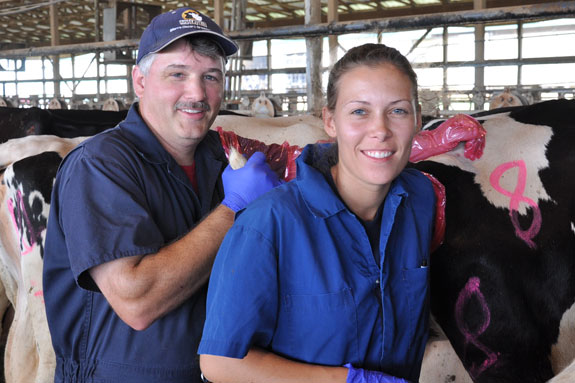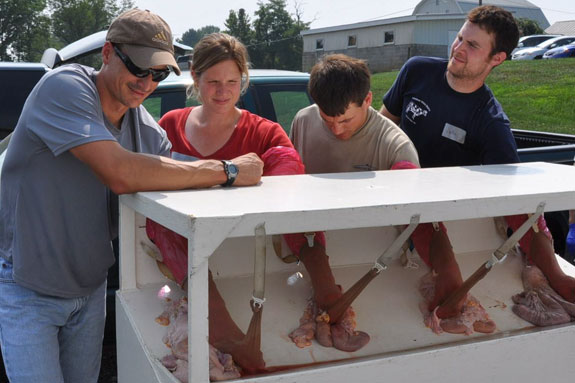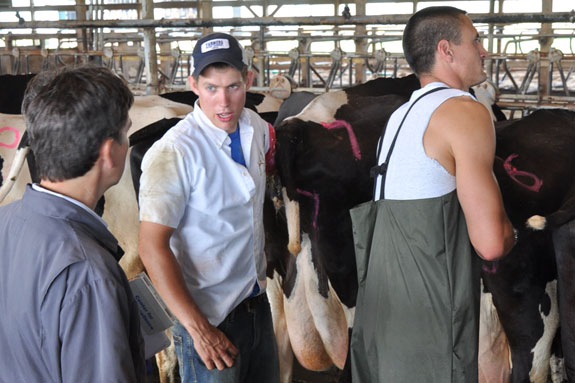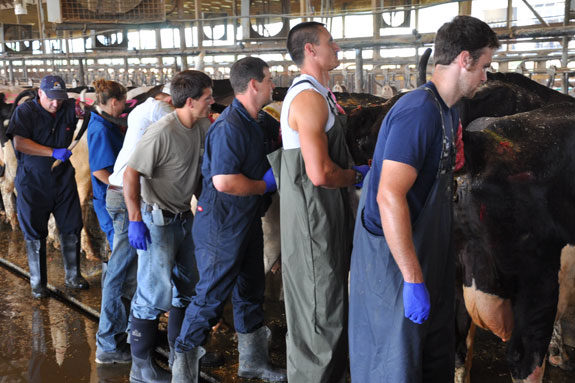Three days of intense training produce more than just sore arms for students of Precision Diagnostic’s embryo transfer course. A diverse group of herdsmen and veterinarians from Maine to Pennsylvania gathered in August to learn the process of transferring embryos into recipient cattle.
Participants came away with a valuable skill they can use at their own farms or in veterinarian practice. Embryo transfer is the quickest way to improve the maternal side of a herd and is tool to help produce higher quality cattle. Krieder Farms of Manheim, Pennsylvania, provided an ideal environment to learn the process.
In 1890, Walter Heape was the first person to successfully transfer embryos. He birthed 2 Angora rabbits from embryos he transferred into a Belgian doe. He successfully speared the embryos onto the tip of a needle and implanted them into the recipient. The first E.T. calf was born in 1951, but not until the 1970’s, did E.T. become used commercially.
Non surgical techniques in the 1980’s allowed embryo transfer to be adopted at the farm and made possibilities attractive to dairy producers. The technology is widely used, reliable and a cost effective process. Today, Doug Speicher and Nate Cossaboom teach others how to improve cattle by way of embryos.
Doug is a veteran A.I technician and reproductive consultant for Precision Diagnostics in New Holland, Pennsylvania. He specializes in English and Spanish training of A.I. and E.T. He also promotes Biopryn pregnancy testing.

Nate Cossaboom is also a veteran A.I technician and has been an embryo transfer technician for 12 years. Nate is from Fayette, Maine, where he operates his own company, Bovine Genetics . The pair teaches the three day course twice a year. It is limited to ten people but open to anyone willing to learn.
“We always get a mix of people at our course”, commented Nate. “We have veterinarians, veterinarian students, experienced dairy and beef farmers, and A.I technicians taking the course."
The first day of the course was focused on learning about the benefits to embryo placement, bovine anatomy and physiology, palpating corpus luteums or follicles on the ovary, and the prerequisites for recipient cattle. The students also palpated open cows and pass E.T. guns in the afternoon.

The second day of the course was devoted to handling frozen embryos and the equipment used for placement. Course participants practiced safely pulling frozen embryos and loading the E.T. Gun. The two instructors then guided students in the afternoon on live cattle.
Day three was focused on understanding genetics of embryos, how to complete the necessary paperwork needed, and how to get embryos. Finally, students practiced the full E.T. procedure on live cows. Both Nate and Doug took all the steps needed to ensure the comfort and safety of the cattle as well as students at the course.
Among those who took the course was third year, University of Pennsylvania Vet School student, Curt Beidel of Shippensburg, Pennsylvania.
Curt says, “I wanted the training because I figured it will make me a better bovine veterinarian. It will make me more marketable as a vet when I graduate.”
Similar thoughts came from Joy Lenker, DVM, of Sunbury Animal Hospital: “My clients like to better their herds with embryo transfer. As a bovine practitioner, I figure it’s an area of improvement for my clients and my practice.”
Casey Douin of Sidney, Maine, enrolled in the course because she is applying to several veterinarian colleges next year and knows improving her knowledge will help her along.
Other students like Sandy Boardman, from a 60-cow farm in Canaan, Connecticut, stated, “The first day was not easy but, I will definitely use what I have learned on the farm.”
Another student was Justin Risser of Bainbridge, Pennsylvania, who currently uses ultrasound technology at his dairy. He hopes to use the skills learned to become better with ultrasound and more self-sufficient because it saves the farm time and money.

Ben Crooke was from a 75-cow dairy in Bucks County, Pennsylvania. He wanted to learn more about ovaries and ways to improve his herd.
“My big frustration the first day was trusting what I was feeling at the palpation table and in live cows,” he says.
Instructor Nate Cossaboom explained that he enjoys seeing his students go from frustration to confidence as the course progresses.
Doug Speicher commented, “The most rewarding aspect of training people is seeing someone come in with limited knowledge, and they leave with the skills they need to be able to palpate ovaries, detect CL’s and safely place an embryo into a cows uterus.”
For more information about an embryo transfer course, contact Bovine Genetics, 877-60-BOVINE or Precision Diagnostics 717-354-2178.
PHOTOS:
TOP RIGHT: E.T. students came prepared to work in recipient cows.
TOP LEFT: Instructor Nate Cossaboom poses with Casey Douin, who traveled from Maine to learn E.T. techniques.
MIDDLE RIGHT: E.T. students, from left to right: Curt Beidel, Joy Lenker, Joel Krall and Justin Risser, palpate ovaries.
MIDDLE LEFT: Instructor Dough Speicher advises Penn State student Ben Crooke and UPenn vet student Curt Beidel.
--Information and photos provided by J.C. Remsberg, freelance writer




